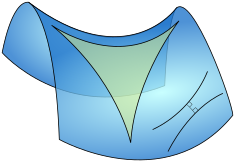
Back هندسة تفاضلية Arabic Xeometría diferencial AST Дыферэнцыяльная геаметрыя Byelorussian Диференциална геометрия Bulgarian ব্যবকলনীয় জ্যামিতি Bengali/Bangla Geometria diferencial Catalan Diferenciální geometrie Czech Дифференциаллă геометри CV Differentialgeometri Danish Differentialgeometrie German
This article needs editing to comply with Wikipedia's Manual of Style. In particular, it has problems with MOS:MATHSPECIAL for \ - needs <math>...</math> markup. (January 2024) |

| Geometry |
|---|
 |
| Geometers |
Differential geometry is a mathematical discipline that studies the geometry of smooth shapes and smooth spaces, otherwise known as smooth manifolds. It uses the techniques of differential calculus, integral calculus, linear algebra and multilinear algebra. The field has its origins in the study of spherical geometry as far back as antiquity. It also relates to astronomy, the geodesy of the Earth, and later the study of hyperbolic geometry by Lobachevsky. The simplest examples of smooth spaces are the plane and space curves and surfaces in the three-dimensional Euclidean space, and the study of these shapes formed the basis for development of modern differential geometry during the 18th and 19th centuries.
Since the late 19th century, differential geometry has grown into a field concerned more generally with geometric structures on differentiable manifolds. A geometric structure is one which defines some notion of size, distance, shape, volume, or other rigidifying structure. For example, in Riemannian geometry distances and angles are specified, in symplectic geometry volumes may be computed, in conformal geometry only angles are specified, and in gauge theory certain fields are given over the space. Differential geometry is closely related to, and is sometimes taken to include, differential topology, which concerns itself with properties of differentiable manifolds that do not rely on any additional geometric structure (see that article for more discussion on the distinction between the two subjects). Differential geometry is also related to the geometric aspects of the theory of differential equations, otherwise known as geometric analysis.
Differential geometry finds applications throughout mathematics and the natural sciences. Most prominently the language of differential geometry was used by Albert Einstein in his theory of general relativity, and subsequently by physicists in the development of quantum field theory and the standard model of particle physics. Outside of physics, differential geometry finds applications in chemistry, economics, engineering, control theory, computer graphics and computer vision, and recently in machine learning.
© MMXXIII Rich X Search. We shall prevail. All rights reserved. Rich X Search